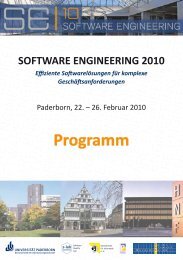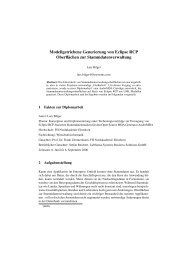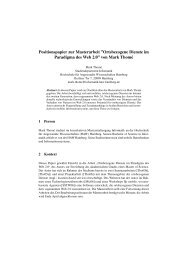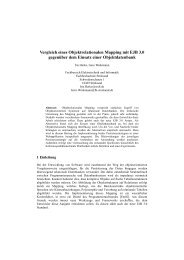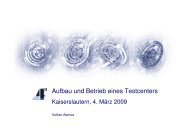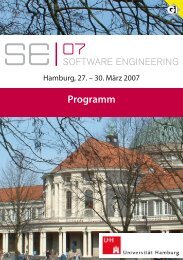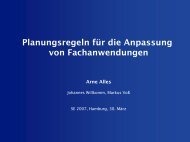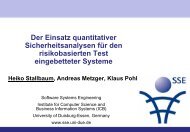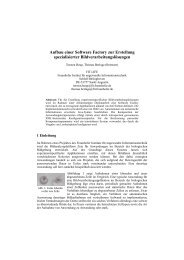A Domain-Specific Language for Industrial Automation - Software ...
A Domain-Specific Language for Industrial Automation - Software ...
A Domain-Specific Language for Industrial Automation - Software ...
Create successful ePaper yourself
Turn your PDF publications into a flip-book with our unique Google optimized e-Paper software.
A <strong>Domain</strong>-<strong>Specific</strong> <strong>Language</strong> <strong>for</strong> <strong>Industrial</strong> <strong>Automation</strong> 1<br />
Stefan Preuer<br />
Christian Doppler Laboratory <strong>for</strong> Automated <strong>Software</strong> Engineering<br />
Johannes Kepler University, Altenberger Straße 69, A-4040 Linz, Austria<br />
preuer@ase.jku.at<br />
Abstract: <strong>Software</strong> development is a complex task and there<strong>for</strong>e requires professional<br />
programming skills. Restricting the focus to a specific problem domain allows<br />
the application of domain-specific concepts and techniques that enable domain<br />
experts to develop software without being professional programmers. This<br />
paper describes such an approach in the area of industrial automation, where a new<br />
domain-specific language Mocol, together with a virtual machine and a development<br />
environment has been developed.<br />
1 Introduction<br />
General-purpose programming languages like C#, Java, or C++ are widely used today.<br />
They provide a variety of general concepts, which make them applicable to almost all<br />
kinds of problems. However, these languages require a deep understanding of their concepts<br />
to produce reliable and maintainable programs. These skills can only be expected<br />
from professional software developers. <strong>Specific</strong> problem domains often do not need this<br />
sophistication. On the other hand, these domains require specific concepts that are not<br />
directly provided by general-purpose languages. A language based on domain concepts<br />
can simplify software development. It does not require professional software developers,<br />
but allows domain experts to adequately develop software in an efficient way.<br />
In my already finished diploma thesis a domain specific language <strong>for</strong> the automation and<br />
coordination of activities at a teeming plat<strong>for</strong>m of a continuous caster was developed.<br />
The goal of this language named Mocol (Motion Control <strong>Language</strong>) is to ease the development<br />
of programs in that area in order to allow people at the plant site to per<strong>for</strong>m<br />
certain programming tasks without needing high-level programming skills. During my<br />
diploma thesis I was employed at the Christian-Doppler Laboratory <strong>for</strong> Automated <strong>Software</strong><br />
Engineering, which is a research laboratory strongly focused on industrial cooperation.<br />
The industrial partner <strong>for</strong> my work was Siemens VAI, the world’s leading engineering<br />
and plant-building company <strong>for</strong> the iron and steel industry.<br />
1 This work was per<strong>for</strong>med in cooperation with Siemens VAI, Austria, and has been supported by the Christian<br />
Doppler Forschungsgesellschaft, Austria.
2 Approach<br />
The diploma thesis had a fix deadline, which resulted from its involvement in a running<br />
project within Siemens VAI. Because of this deadline a total time of seven month was<br />
scheduled <strong>for</strong> the thesis. Since a very detailed draft <strong>for</strong> the language Mocol was proposed<br />
by Siemens VAI at the beginning of my thesis the most extensive part was the<br />
design and implementation of a compiler, virtual machine and integrated development<br />
environment <strong>for</strong> the language. Anyhow, the really crucial factor was the fit of the language<br />
Mocol itself. There<strong>for</strong>e in a first step an evaluation of the proposed language took<br />
place. For this task experiences of colleagues researching in a similar area were very<br />
helpful. This potential <strong>for</strong> synergies was also an important reason why the work <strong>for</strong> the<br />
thesis was done within the context of the Christian Doppler Laboratories <strong>for</strong> Automated<br />
<strong>Software</strong> Engineering. Although some possible enhancements <strong>for</strong> the language were<br />
found, beside some minor changes the originally proposed language has been retained<br />
almost unchanged. The main reason <strong>for</strong> this decision was to keep the language as simple<br />
as possible but at the same time as complex as necessary. Based on the available domain<br />
knowledge at that time the proposed enhancements seemed to make the language unnecessarily<br />
complex. So the basic approach was to develop a prototypical implementation<br />
based on the draft of the language Mocol, and use this prototype to gain further knowledge<br />
about the requirements on the language. This approach required a strong willingness<br />
<strong>for</strong> change, which in general is a fundamental requirement <strong>for</strong> successful software<br />
engineering. The major driving <strong>for</strong>ce <strong>for</strong> this change was the gain of knowledge about<br />
the domain the language is targeted <strong>for</strong>. Also very important was the implementation of<br />
software components simulating the behaviour of real world components which activities<br />
the language should coordinate. This allowed a com<strong>for</strong>table way of testing the system<br />
and especially to write automatically repeatable test cases. Such automatic tests are<br />
crucial to reach a high quality in a steady evolving software system, because it provides<br />
you with certainty that changes did not negatively influence already tested functionality.<br />
The following chapters very shortly explain the technical aspects of the developed software<br />
system.<br />
3 Environment<br />
The whole system responsible <strong>for</strong> the coordination of the activities at the teeming plat<strong>for</strong>m<br />
is called Motion Controller. To cope with the complexity of the system its architecture<br />
was designed with a clean layering. An important result of this layering is the abstraction<br />
from the hardware of the components to be coordinated. The pivotal component<br />
typically is an industrial robot. Other components are <strong>for</strong> example a repository <strong>for</strong> various<br />
tools, a positioning system, or a human machine interface. The Mocol VM is the<br />
heart of the Motion Controller. It is an interpreter <strong>for</strong> Mocol programs, which uses a<br />
component abstraction layer to interact with the hardware components and on the other<br />
hand acts as a server application allowing different clients to use its services. In productive<br />
mode such a client typically is an expert system, which decides what programs to<br />
start. Another client can be an integrated development environment <strong>for</strong> the development<br />
of Mocol programs. Figure 1 shows this layering.
Client (Expert System / IDE)<br />
Mocol VM<br />
Component Abstraction Layer<br />
Components<br />
<strong>Software</strong><br />
Hardware<br />
Figure 1: Basic layering of the Motion Controller<br />
4 The <strong>Domain</strong>-specific Programming <strong>Language</strong> Mocol<br />
Automating and coordinating activities on a teeming plat<strong>for</strong>m requires some fundamental<br />
concepts that a domain-specific language should be able to express in a simple way.<br />
In Mocol the most important concepts are:<br />
• Interaction with the components abstracting from their real implementation.<br />
There<strong>for</strong>e, the Mocol interface of each component consists of properties, commands<br />
and events or errors.<br />
• Explicit and implicit parallelism.<br />
• Waiting on state-specific conditions of the components.<br />
• Expressing timing constraints.<br />
• Handling of asynchronous and synchronous events and errors during the execution<br />
of a program.<br />
• Managing data channels between components.<br />
• Checking <strong>for</strong> preconditions which must hold be<strong>for</strong>e a program is executed.<br />
Beside these specific requirements Mocol offers general concepts of structured programming.<br />
Listing 1 shows an example of a Mocol program measuring the temperature<br />
of the liquid steel in a tundish.<br />
PROGRAM TemperatureMeasurement<br />
PARAMETERS<br />
speed AS NUMBER<br />
USE Roboter, Repository, MeasureBox<br />
PRECONDITIONS<br />
Roboter.IsInHomePosition, NOT Repository.NoTempLance<br />
EVENTS<br />
ON Repository.Empty NAMED Handler: EXEC Repository.RequestLances<br />
ERRORS<br />
ON ANY: EXIT 100<br />
BEGIN<br />
ACTIVATE Handler<br />
Roboter.Speed := speed<br />
CONNECT Roboter.Position TO Hmi.PositionMonitor<br />
PAR EXEC Roboter.MoveToRepository || EXEC Repository.RequestTempLance END<br />
WAIT Repository.TakeOverOk AND Repository.LanceOk MAX 10000<br />
EXEC Roboter.MoveToTakeOverPosition ( Repository.SelectedLanceSlot )<br />
WAIT Repository.TakeOverComplete MAX 5000<br />
EXEC Roboter.MoveToTundish
START Roboter.DipLanceIntoLadle<br />
EXEC MeasureBox.PrepareProbeAdmission<br />
JOIN Roboter.DipLanceIntoLadle<br />
EXEC Roboter.DeliverProbe<br />
IF MeasureBox.MeasureOk THEN EXEC MeasureBox.DisposeProbe END<br />
EXEC Roboter.MoveToHome<br />
END<br />
Listing 1: Example of a Mocol program<br />
5 The Mocol VM<br />
The Mocol VM allows the interpreted execution of Mocol programs. There<strong>for</strong>e a compiler<br />
generates an abstract syntax tree (AST) out of a Mocol source file. The compiler<br />
itself is generated by Coco/R [MLW06], a compiler generator using an attributed grammar<br />
(ATG) as input. Based on the AST the interpreter is responsible <strong>for</strong> the actual execution<br />
of Mocol programs and provides debugging functionality. Figure 2 shows the<br />
generation of the compiler, and its embedding in the whole architecture of the Mocol<br />
VM.<br />
Compiler-Main<br />
Server<br />
ATG<br />
Coco/R<br />
Parser<br />
Debugging<br />
Interpreter<br />
Scanner<br />
semantic classes<br />
Compiler<br />
Access layer<br />
Figure 2: Mocol Compiler in context of the whole Mocol VM<br />
6 Summary and Results<br />
The implemented Motion Controller as a result of the diploma thesis allows the easy<br />
description and execution of coordination activities. Nevertheless, further enhancements<br />
are necessary to improve the applicability. In particular, a more elaborate model <strong>for</strong> the<br />
treatment of error situations is required. These enhancements are planned to get integrated<br />
in the current solution and there<strong>for</strong>e <strong>for</strong>m a further evolutionary step in the development<br />
of the Motion Controller.<br />
References<br />
[MLW06] Mössenböck, H., Löberbauer, M., Wöß, A.: User Manual of the Compiler Generator<br />
Coco/R. http://ssw.jku.at/Coco/



